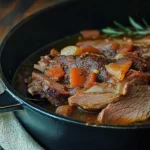The aroma alone is enough to transport me back to my Bubbe’s kitchen. Sunday dinners at her house were legendary, and at the heart of nearly every holiday feast, and many regular Sundays in between, was her Jewish Brisket. Not just any brisket, mind you. This was the brisket. Slow-cooked to meltingly tender perfection, infused with the sweet and savory flavors of onions, garlic, and a hint of tomato, it was the epitome of comfort food and family tradition. I remember the anticipation building as the rich, savory scent wafted through the house all afternoon, promising a meal that was more than just food; it was love on a plate. Now, years later, I cherish the memory of those meals and the recipe that Bubbe lovingly passed down. It’s more than just a recipe; it’s a connection to my heritage, a taste of home, and a dish that never fails to impress and nourish both body and soul. Whether it’s Rosh Hashanah, Passover, or just a cozy Sunday supper, Jewish Brisket is a centerpiece that brings people together, and this recipe, honed over generations, is my gift to you, so you can create your own cherished memories.
Ingredients for Authentic Jewish Brisket
Creating truly exceptional Jewish Brisket relies on a careful selection of simple yet high-quality ingredients. Each element contributes to the depth of flavor and tender texture that makes this dish so beloved. Here’s a detailed list of what you’ll need to bring this classic recipe to life:
The Brisket Itself:
- Beef Brisket: 3-4 lbs (approximately 1.3-1.8 kg) – This is the star of the show! Look for a first-cut brisket (also known as the flat cut or lean cut). First-cut brisket is leaner and more uniform in shape, which is ideal for braising and slicing. Second-cut brisket (the point cut or deckle) is fattier and more marbled, which is great for smoking but can be a bit too rich for traditional Jewish Brisket. If you can only find a whole brisket (packer brisket), you can use it, but you may want to trim some of the excess fat, especially from the point cut, to prevent the final dish from being overly greasy. The weight will vary depending on how many people you are serving, but 3-4 lbs is generally good for 6-8 servings.
Aromatic Vegetables:
- Onions: 2 large, thinly sliced – Yellow onions are the standard choice for Jewish Brisket, providing a sweet and savory base flavor as they caramelize during the long braising process. You can also use white onions, but yellow onions tend to become sweeter and more mellow when cooked for a long time.
- Garlic: 4-6 cloves, minced – Fresh garlic is essential for adding a pungent and aromatic depth. Use more or less depending on your garlic preference. Mincing the garlic ensures it infuses its flavor throughout the brisket and sauce.
- Carrots: 2 large, peeled and cut into 1-inch pieces (optional but highly recommended) – Carrots add sweetness and a touch of color to the brisket. They also become incredibly tender and flavorful as they braise alongside the meat. Cutting them into larger pieces prevents them from becoming mushy during the long cooking time.
- Celery: 2 stalks, cut into 1-inch pieces (optional but recommended for depth of flavor) – Celery, like carrots, adds another layer of subtle sweetness and savory depth to the brisket. It also contributes to the aromatic base of the braising liquid.
Flavorful Liquids and Seasonings:
- Beef Broth: 2 cups – Low-sodium beef broth is recommended to control the salt level. High-quality beef broth will enhance the overall richness and beefy flavor of the brisket. You can also use homemade beef broth for even better results.
- Tomato Paste: 2 tablespoons – Tomato paste adds depth and umami richness to the braising liquid. It also helps to create a slightly thicker and more flavorful sauce.
- Dry Red Wine (Optional): 1 cup – A dry red wine, such as Cabernet Sauvignon, Merlot, or Burgundy, adds complexity and depth of flavor to the brisket. The alcohol cooks off during braising, leaving behind a rich, savory undertone. If you prefer not to use wine, you can substitute an equal amount of beef broth.
- Bay Leaves: 2-3 leaves – Bay leaves infuse a subtle, earthy, and slightly floral aroma into the brisket. They are essential for adding depth and complexity to the braising liquid. Remember to remove them before serving.
- Dried Thyme: 1 teaspoon – Dried thyme provides a warm, slightly peppery, and herbaceous note that complements the beef and other aromatics beautifully.
- Paprika: 1 tablespoon – Sweet paprika is typically used in Jewish Brisket, adding a mild sweetness and a subtle smoky note, as well as contributing to the rich color of the sauce. You can also use smoked paprika for a more pronounced smoky flavor, or a blend of sweet and smoked.
- Salt: 2 teaspoons (or to taste) – Kosher salt is preferred for seasoning meat. Adjust the amount of salt to your taste, keeping in mind that the beef broth and tomato paste also contain salt.
- Black Pepper: 1 teaspoon (freshly ground) – Freshly ground black pepper provides a more pungent and aromatic pepper flavor.
Optional Ingredients (for variations and enhancements):
- Potatoes: 1-2 lbs, peeled and quartered (Yukon Gold or Russet potatoes work well) – Adding potatoes to the brisket during the last hour or so of cooking allows them to braise in the flavorful liquid and become incredibly tender and infused with flavor.
- Sweet Potatoes: 1-2 lbs, peeled and quartered – Sweet potatoes offer a sweeter and slightly different flavor profile compared to regular potatoes, and they also braise beautifully alongside the brisket.
- Prunes or Dried Apricots: 1/2 cup (pitted prunes or dried apricots) – Adding prunes or dried apricots is a classic touch in some Jewish Brisket recipes, particularly those with a sweeter flavor profile. They add a subtle sweetness and a lovely chewy texture.
- Apple Cider Vinegar: 1-2 tablespoons – A splash of apple cider vinegar can brighten the flavors and add a touch of acidity to balance the richness of the brisket.
Detailed Instructions for Making Tender and Flavorful Jewish Brisket
Following these step-by-step instructions will guide you through the process of creating a truly melt-in-your-mouth, flavorful Jewish Brisket that will impress your family and guests. Whether you choose to braise it in the oven or use a slow cooker, the key is patience and low, slow cooking.
Step 1: Prepare the Brisket
- Preheat Oven (for oven method): Preheat your oven to 325°F (160°C).
- Pat Brisket Dry: Pat the brisket dry with paper towels. This helps it to brown better in the next step.
- Season Brisket: Season the brisket generously on all sides with salt and black pepper. Don’t be shy with the seasoning – this is a large cut of meat and needs ample seasoning to penetrate and flavor it throughout.
- Sear Brisket (Important for Flavor): Heat 2 tablespoons of olive oil or vegetable oil in a large Dutch oven or oven-safe pot over medium-high heat. Once the oil is hot and shimmering, carefully place the brisket in the pot and sear it on all sides until nicely browned, about 3-5 minutes per side. Searing creates a flavorful crust and enhances the overall richness of the brisket. Remove the brisket from the pot and set aside.
Step 2: Sauté Aromatics and Build Flavor Base
- Sauté Onions and Garlic: In the same pot (no need to clean it), add the sliced onions and cook over medium heat until softened and lightly caramelized, about 8-10 minutes, stirring occasionally. Caramelizing the onions adds sweetness and depth of flavor.
- Add Garlic, Carrots, and Celery (Optional): Add the minced garlic, carrots, and celery (if using) to the pot and cook for another 5 minutes, stirring occasionally, until the garlic is fragrant and the vegetables are slightly softened.
- Stir in Tomato Paste and Spices: Add the tomato paste, paprika, and dried thyme to the pot and cook for 1-2 minutes, stirring constantly, until fragrant. Cooking the tomato paste deepens its flavor.
- Deglaze with Red Wine (Optional): If using red wine, pour it into the pot and scrape the bottom with a wooden spoon to loosen any browned bits (fond) that have accumulated. Cook until the wine has reduced slightly, about 2-3 minutes. This step adds a layer of complexity to the sauce.
Step 3: Braise the Brisket
- Add Beef Broth and Bay Leaves: Pour in the beef broth and add the bay leaves to the pot. Stir to combine all the ingredients.
- Return Brisket to Pot: Return the seared brisket to the pot, nestling it into the vegetable and broth mixture. The liquid should come about halfway up the sides of the brisket. If needed, add a little more beef broth to reach this level.
- Bring to Simmer, Then Braise: Bring the liquid to a simmer on the stovetop. Then, cover the pot tightly with a lid.
- Oven Braising: Transfer the covered pot to the preheated oven and braise for 3-4 hours, or until the brisket is fork-tender. Check the brisket after 3 hours; it should be easily pierced with a fork with very little resistance. If it’s not quite tender, continue braising for another 30-60 minutes.
- Slow Cooker Braising: Transfer the onion mixture and brisket to a slow cooker. Pour in the beef broth, tomato paste mixture, and red wine (if using). Add bay leaves. Cook on low for 8-10 hours or on high for 4-5 hours, or until the brisket is fork-tender.
- Add Potatoes and/or Sweet Potatoes (Optional): If using potatoes and/or sweet potatoes, add them to the pot during the last hour of braising. Nestle them around the brisket and ensure they are partially submerged in the braising liquid. They will become incredibly tender and flavorful as they cook.
Step 4: Rest and Slice the Brisket
- Remove Brisket and Vegetables: Once the brisket is fork-tender, carefully remove it from the pot and place it on a cutting board. Remove the vegetables from the pot with a slotted spoon and set aside. Discard the bay leaves.
- Skim Fat (Optional but Recommended): If desired, skim off some of the excess fat from the surface of the braising liquid in the pot using a spoon or a fat separator. This will result in a leaner sauce.
- Slice Brisket Against the Grain: Let the brisket rest for at least 15-20 minutes before slicing. This allows the juices to redistribute, resulting in a more tender and flavorful brisket. Identify the grain of the brisket (the direction of the muscle fibers) and slice it against the grain in thick slices (about 1/4-inch to 1/2-inch thick). Slicing against the grain is crucial for tender brisket, as it shortens the muscle fibers.
- Return Brisket to Sauce: Return the sliced brisket to the pot with the braising sauce and vegetables. Gently reheat over low heat until warmed through.
- Taste and Adjust Seasoning: Taste the sauce and adjust seasoning as needed. You may want to add more salt, pepper, or a touch of apple cider vinegar to brighten the flavors.
- Serve: Serve hot, spooning the sauce and vegetables over the sliced brisket. Garnish with fresh parsley, if desired.
Nutritional Information for Jewish Brisket
This nutritional information is an estimate and can vary based on the specific ingredients used, the cut of brisket, and portion sizes. It is important to note that this is for one serving and assumes the recipe makes approximately 8 servings.
Serving Size: Approximately 4-5 ounces of brisket with sauce and vegetables
Calories per serving: Approximately 450-550 calories
Approximate Nutritional Breakdown (per serving):
- Protein: 40-50g
- Fat: 25-35g (depending on the fat content of the brisket and trimming)
- Saturated Fat: 10-15g (depending on the fat content of the brisket and trimming)
- Cholesterol: 150-200mg
- Sodium: 500-700mg (depending on broth and salt added)
- Carbohydrates: 10-15g (mostly from vegetables)
- Fiber: 2-3g
- Sugar: 5-7g (naturally occurring sugars from vegetables and wine)
Important Notes:
- These values are estimates and can vary.
- Using a leaner first-cut brisket and trimming excess fat will reduce the fat and calorie content.
- Adding potatoes and/or sweet potatoes will increase the carbohydrate and calorie content.
- Serving with additional sides like mashed potatoes or noodles will further increase the carbohydrate and calorie content of the meal.
- To reduce sodium, use low-sodium beef broth and adjust salt to taste.
Preparation Time for Jewish Brisket
While the cooking time for Jewish Brisket is long and slow, the active preparation time is relatively manageable.
- Prep Time: 30-40 minutes (This includes slicing onions, mincing garlic, chopping vegetables, searing brisket, and assembling ingredients.)
- Cook Time: 3-4 hours (oven braising) or 8-10 hours (slow cooker braising)
- Total Time (Oven): Approximately 3 hours 30 minutes – 4 hours 40 minutes
- Total Time (Slow Cooker): Approximately 8 hours 30 minutes – 10 hours 40 minutes
The majority of the time is hands-off braising, allowing you to focus on other tasks while the brisket becomes incredibly tender and flavorful. Jewish Brisket is a dish that rewards patience!
How to Serve Jewish Brisket: Classic and Delicious Pairings
Jewish Brisket is a versatile centerpiece that pairs beautifully with a variety of traditional and contemporary side dishes. Here are some classic and delicious serving suggestions:
- Classic Jewish Holiday Sides:
- Potato Latkes: Crispy potato pancakes are a quintessential Hanukkah pairing but delicious year-round with brisket.
- Matzah Ball Soup: A comforting and traditional Jewish soup, often served as a starter before brisket, especially during Passover.
- Kugel: Sweet noodle kugel (often with raisins or apples) or savory potato kugel are classic accompaniments.
- Tzimmes: A sweet and savory carrot stew, often with prunes or sweet potatoes, complements the brisket’s flavors beautifully.
- Chopped Liver: A traditional Jewish appetizer, often served before the main course.
- Comforting Starchy Sides:
- Mashed Potatoes: Creamy mashed potatoes are a perfect vehicle for soaking up the rich brisket sauce.
- Roasted Potatoes: Roasted potatoes (especially those roasted with herbs and garlic) are another great option.
- Egg Noodles: Buttered egg noodles or noodles tossed with parsley are a simple and satisfying side.
- Rice Pilaf: A fluffy rice pilaf provides a lighter starchy side.
- Polenta: Creamy polenta is a more modern and elegant option.
- Fresh and Vibrant Vegetable Sides:
- Roasted Asparagus: Adds a touch of green and a slightly bitter note to balance the richness.
- Steamed Green Beans: A simple and healthy side.
- Roasted Brussels Sprouts: Roasted Brussels sprouts with balsamic glaze or maple syrup offer a sweet and savory contrast.
- Green Salad: A fresh green salad with a vinaigrette dressing provides a refreshing counterpoint.
- Cucumber Salad: A light and tangy cucumber salad is a refreshing and traditional side.
- Bread for Sopping Up Sauce:
- Challah Bread: A soft and slightly sweet braided bread, perfect for dipping in the brisket sauce.
- Crusty Bread: Slices of crusty sourdough or baguette are also excellent for soaking up the sauce.
Expert Tips for Making the Best Jewish Brisket Ever
To elevate your Jewish Brisket to legendary status, consider these expert tips honed from years of brisket-making experience:
- Choose the Right Cut of Brisket: As mentioned earlier, first-cut brisket (flat cut) is generally preferred for Jewish Brisket due to its leaner profile and uniform shape. Avoid second-cut brisket (point cut) unless you are comfortable trimming excess fat.
- Don’t Skip the Searing: Searing the brisket is a crucial step that significantly enhances the flavor. It creates a Maillard reaction, developing complex and savory notes that braising alone cannot achieve. Make sure the pan is hot and the brisket is patted dry for optimal searing.
- Low and Slow is Key: Patience is your best friend when making Jewish Brisket. Braising it low and slow for several hours is essential for breaking down the tough connective tissue and rendering the brisket meltingly tender. Resist the urge to rush the cooking process.
- Slice Against the Grain: Slicing the brisket against the grain is absolutely critical for tenderness. Identify the direction of the muscle fibers and cut perpendicular to them. This shortens the muscle fibers, making each bite more tender and easier to chew.
- Make it Ahead of Time (It Gets Better with Time!): Jewish Brisket is one of those dishes that actually tastes even better the next day. Braising it a day or two in advance allows the flavors to meld and deepen beautifully. After braising, let it cool slightly, then slice it and store it in the braising liquid in the refrigerator. Reheat gently before serving.
Frequently Asked Questions (FAQs) About Jewish Brisket
Here are some frequently asked questions to help you master the art of making Jewish Brisket:
Q1: Can I use a slow cooker for Jewish Brisket?
A1: Yes, a slow cooker is an excellent option for making Jewish Brisket, especially for hands-off cooking. The slow, gentle heat of the slow cooker is perfect for braising brisket until it’s incredibly tender. Follow the slow cooker instructions provided earlier in the recipe. Searing the brisket before adding it to the slow cooker is still recommended for optimal flavor.
Q2: How do I prevent my brisket from drying out?
A2: The key to preventing dry brisket is braising it in enough liquid and cooking it low and slow. Ensure the brisket is partially submerged in the braising liquid throughout the cooking process. Don’t overcook it; braise it just until it’s fork-tender, not falling apart. Resting the brisket after cooking and before slicing also helps to retain moisture.
Q3: Can I freeze leftover Jewish Brisket?
A3: Yes, Jewish Brisket freezes very well. Allow the brisket and sauce to cool completely. Then, transfer them to freezer-safe containers or freezer bags, ensuring the brisket is submerged in the sauce to prevent freezer burn. Freeze for up to 2-3 months. Thaw overnight in the refrigerator and reheat gently on the stovetop or in the oven until heated through.
Q4: What if my brisket is tough after cooking?
A4: If your brisket is still tough after the recommended cooking time, it simply needs to braise longer. Brisket is a tough cut of meat and requires significant time to break down the connective tissue. Return the brisket to the pot, add a little more beef broth if needed, and continue braising for another hour or two, checking for tenderness periodically.
Q5: Can I make Jewish Brisket without red wine?
A5: Yes, you can easily make Jewish Brisket without red wine. Simply omit the red wine from the recipe and substitute an equal amount of beef broth. While the red wine adds depth and complexity, the brisket will still be delicious without it. You can also try adding a tablespoon of balsamic vinegar or apple cider vinegar for a touch of acidity if you omit the wine.
Print
Jewish Brisket recipe
Ingredients
-
- Beef Brisket: 3-4 lbs (approximately 1.3-1.8 kg) – This is the star of the show! Look for a first-cut brisket (also known as the flat cut or lean cut). First-cut brisket is leaner and more uniform in shape, which is ideal for braising and slicing. Second-cut brisket (the point cut or deckle) is fattier and more marbled, which is great for smoking but can be a bit too rich for traditional Jewish Brisket. If you can only find a whole brisket (packer brisket), you can use it, but you may want to trim some of the excess fat, especially from the point cut, to prevent the final dish from being overly greasy. The weight will vary depending on how many people you are serving, but 3-4 lbs is generally good for 6-8 servings.
Aromatic Vegetables:
-
- Onions: 2 large, thinly sliced – Yellow onions are the standard choice for Jewish Brisket, providing a sweet and savory base flavor as they caramelize during the long braising process. You can also use white onions, but yellow onions tend to become sweeter and more mellow when cooked for a long time.
-
- Garlic: 4-6 cloves, minced – Fresh garlic is essential for adding a pungent and aromatic depth. Use more or less depending on your garlic preference. Mincing the garlic ensures it infuses its flavor throughout the brisket and sauce.
-
- Carrots: 2 large, peeled and cut into 1-inch pieces (optional but highly recommended) – Carrots add sweetness and a touch of color to the brisket. They also become incredibly tender and flavorful as they braise alongside the meat. Cutting them into larger pieces prevents them from becoming mushy during the long cooking time.
-
- Celery: 2 stalks, cut into 1-inch pieces (optional but recommended for depth of flavor) – Celery, like carrots, adds another layer of subtle sweetness and savory depth to the brisket. It also contributes to the aromatic base of the braising liquid.
Flavorful Liquids and Seasonings:
-
- Beef Broth: 2 cups – Low-sodium beef broth is recommended to control the salt level. High-quality beef broth will enhance the overall richness and beefy flavor of the brisket. You can also use homemade beef broth for even better results.
-
- Tomato Paste: 2 tablespoons – Tomato paste adds depth and umami richness to the braising liquid. It also helps to create a slightly thicker and more flavorful sauce.
-
- Dry Red Wine (Optional): 1 cup – A dry red wine, such as Cabernet Sauvignon, Merlot, or Burgundy, adds complexity and depth of flavor to the brisket. The alcohol cooks off during braising, leaving behind a rich, savory undertone. If you prefer not to use wine, you can substitute an equal amount of beef broth.
-
- Bay Leaves: 2-3 leaves – Bay leaves infuse a subtle, earthy, and slightly floral aroma into the brisket. They are essential for adding depth and complexity to the braising liquid. Remember to remove them before serving.
-
- Dried Thyme: 1 teaspoon – Dried thyme provides a warm, slightly peppery, and herbaceous note that complements the beef and other aromatics beautifully.
-
- Paprika: 1 tablespoon – Sweet paprika is typically used in Jewish Brisket, adding a mild sweetness and a subtle smoky note, as well as contributing to the rich color of the sauce. You can also use smoked paprika for a more pronounced smoky flavor, or a blend of sweet and smoked.
-
- Salt: 2 teaspoons (or to taste) – Kosher salt is preferred for seasoning meat. Adjust the amount of salt to your taste, keeping in mind that the beef broth and tomato paste also contain salt.
-
- Black Pepper: 1 teaspoon (freshly ground) – Freshly ground black pepper provides a more pungent and aromatic pepper flavor.
Optional Ingredients (for variations and enhancements):
-
- Potatoes: 1-2 lbs, peeled and quartered (Yukon Gold or Russet potatoes work well) – Adding potatoes to the brisket during the last hour or so of cooking allows them to braise in the flavorful liquid and become incredibly tender and infused with flavor.
-
- Sweet Potatoes: 1-2 lbs, peeled and quartered – Sweet potatoes offer a sweeter and slightly different flavor profile compared to regular potatoes, and they also braise beautifully alongside the brisket.
-
- Prunes or Dried Apricots: 1/2 cup (pitted prunes or dried apricots) – Adding prunes or dried apricots is a classic touch in some Jewish Brisket recipes, particularly those with a sweeter flavor profile. They add a subtle sweetness and a lovely chewy texture.
-
- Apple Cider Vinegar: 1-2 tablespoons – A splash of apple cider vinegar can brighten the flavors and add a touch of acidity to balance the richness of the brisket.
Instructions
Step 1: Prepare the Brisket
-
- Preheat Oven (for oven method): Preheat your oven to 325°F (160°C).
-
- Pat Brisket Dry: Pat the brisket dry with paper towels. This helps it to brown better in the next step.
-
- Season Brisket: Season the brisket generously on all sides with salt and black pepper. Don’t be shy with the seasoning – this is a large cut of meat and needs ample seasoning to penetrate and flavor it throughout.
-
- Sear Brisket (Important for Flavor): Heat 2 tablespoons of olive oil or vegetable oil in a large Dutch oven or oven-safe pot over medium-high heat. Once the oil is hot and shimmering, carefully place the brisket in the pot and sear it on all sides until nicely browned, about 3-5 minutes per side. Searing creates a flavorful crust and enhances the overall richness of the brisket. Remove the brisket from the pot and set aside.
Step 2: Sauté Aromatics and Build Flavor Base
-
- Sauté Onions and Garlic: In the same pot (no need to clean it), add the sliced onions and cook over medium heat until softened and lightly caramelized, about 8-10 minutes, stirring occasionally. Caramelizing the onions adds sweetness and depth of flavor.
-
- Add Garlic, Carrots, and Celery (Optional): Add the minced garlic, carrots, and celery (if using) to the pot and cook for another 5 minutes, stirring occasionally, until the garlic is fragrant and the vegetables are slightly softened.
-
- Stir in Tomato Paste and Spices: Add the tomato paste, paprika, and dried thyme to the pot and cook for 1-2 minutes, stirring constantly, until fragrant. Cooking the tomato paste deepens its flavor.
-
- Deglaze with Red Wine (Optional): If using red wine, pour it into the pot and scrape the bottom with a wooden spoon to loosen any browned bits (fond) that have accumulated. Cook until the wine has reduced slightly, about 2-3 minutes. This step adds a layer of complexity to the sauce.
Step 3: Braise the Brisket
-
- Add Beef Broth and Bay Leaves: Pour in the beef broth and add the bay leaves to the pot. Stir to combine all the ingredients.
-
- Return Brisket to Pot: Return the seared brisket to the pot, nestling it into the vegetable and broth mixture. The liquid should come about halfway up the sides of the brisket. If needed, add a little more beef broth to reach this level.
-
- Bring to Simmer, Then Braise: Bring the liquid to a simmer on the stovetop. Then, cover the pot tightly with a lid.
-
- Oven Braising: Transfer the covered pot to the preheated oven and braise for 3-4 hours, or until the brisket is fork-tender. Check the brisket after 3 hours; it should be easily pierced with a fork with very little resistance. If it’s not quite tender, continue braising for another 30-60 minutes.
-
- Slow Cooker Braising: Transfer the onion mixture and brisket to a slow cooker. Pour in the beef broth, tomato paste mixture, and red wine (if using). Add bay leaves. Cook on low for 8-10 hours or on high for 4-5 hours, or until the brisket is fork-tender.
-
- Bring to Simmer, Then Braise: Bring the liquid to a simmer on the stovetop. Then, cover the pot tightly with a lid.
-
- Add Potatoes and/or Sweet Potatoes (Optional): If using potatoes and/or sweet potatoes, add them to the pot during the last hour of braising. Nestle them around the brisket and ensure they are partially submerged in the braising liquid. They will become incredibly tender and flavorful as they cook.
Step 4: Rest and Slice the Brisket
-
- Remove Brisket and Vegetables: Once the brisket is fork-tender, carefully remove it from the pot and place it on a cutting board. Remove the vegetables from the pot with a slotted spoon and set aside. Discard the bay leaves.
-
- Skim Fat (Optional but Recommended): If desired, skim off some of the excess fat from the surface of the braising liquid in the pot using a spoon or a fat separator. This will result in a leaner sauce.
-
- Slice Brisket Against the Grain: Let the brisket rest for at least 15-20 minutes before slicing. This allows the juices to redistribute, resulting in a more tender and flavorful brisket. Identify the grain of the brisket (the direction of the muscle fibers) and slice it against the grain in thick slices (about 1/4-inch to 1/2-inch thick). Slicing against the grain is crucial for tender brisket, as it shortens the muscle fibers.
-
- Return Brisket to Sauce: Return the sliced brisket to the pot with the braising sauce and vegetables. Gently reheat over low heat until warmed through.
-
- Taste and Adjust Seasoning: Taste the sauce and adjust seasoning as needed. You may want to add more salt, pepper, or a touch of apple cider vinegar to brighten the flavors.
-
- Serve: Serve hot, spooning the sauce and vegetables over the sliced brisket. Garnish with fresh parsley, if desired.
Nutrition
- Serving Size: one normal portion
- Calories: 450-550
- Sugar: 2-3g
- Sodium: 500-700mg
- Fat: 25-35g
- Saturated Fat: 10-15g
- Carbohydrates: 10-15g
- Fiber: 5-7g
- Protein: 40-50g
- Cholesterol: 150-200mg





